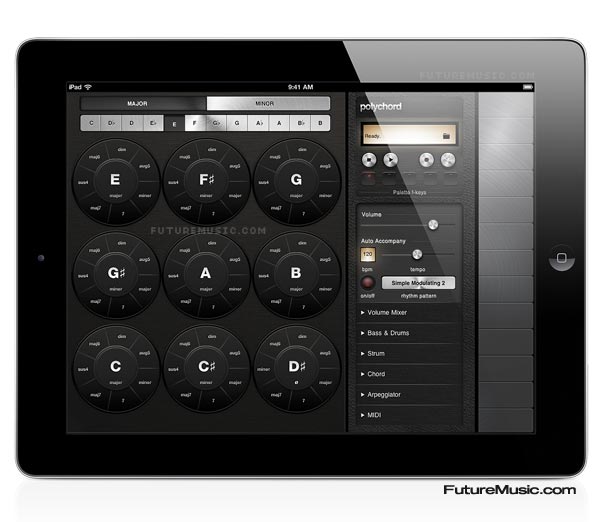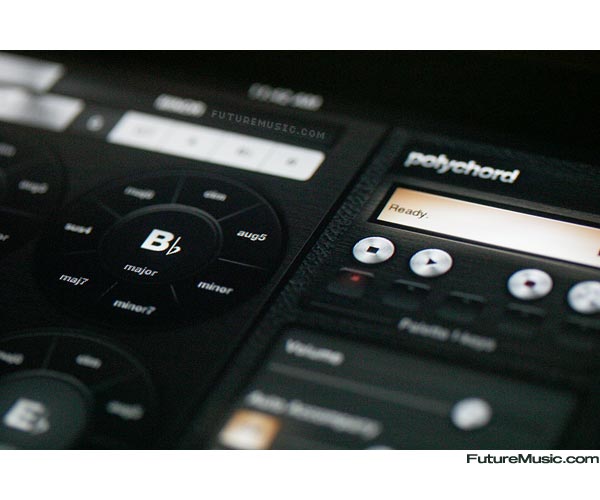Shoulda Woulda Coulda Updates Polychord iPad App To Version 2
Shoulda Woulda Coulda, Inc. is readying a major update to their iPad music composition tool, Polychord. The version 2 update brings a vast quantity of new exciting features to this highly-rated app including the ability to record your song data, a new graphical user interface, and Palettes.

First and foremost, Polychord 2 gives you instant access to over 60 chords at any time via a clever graphical interface that houses each root and its variations in a circle. However, in order for a user to fully flesh out song ideas quickly, Polychord also affords an Auto Accompany feature. Press any chord and the drums and bass will play along in tune with your inspiration. Switch to a different chord and “your rhythm section” follows along with you.
Features:
» Chords: Major, Minor, Seven, Diminished, Half Diminished, Augmented 5th, Sus 4, Major 6, Major 7, Minor Seven
» Scrolling accordion menus for instant access to all features while playing
» Low-latency strum keys and chord buttons
» Fast key change, transposing, major and minor palettes
» Volume mixer, controls for each instrument
» 27 drum & bass patterns for Accompaniment
» Speed/tempo controls
» Bass follows chords (Major, Minor,etc)
» Arpeggiator with speed, direction, and variation controls
» WiFi MIDI Controller
Shoulda Woulda Coulda determined that playing a multitude of chords via a touchscreen piano keyboard interface came up wanting, so they developed a Strum attribute. Polychord’s strum keys change automatically with the chords, so the interface doesn’t have to make room for keys you don’t need. Simply swipe your finger over the yellow keys to strum a chord, and your on your way to creating a new progression.
Enhancements:
» New GUI by Jonas Eriksson
» Palettes – Group Settings Recall
» Sine, Sawtooth, Triangle and Square Waves for each instrument. We used an analogue simulation technique for generating the synthesizer waves, which warms them up a bit.
» Bitshift features for drums: full control over the reduction of bits / bitrate, allowing you to completely decimate the sound or just add a touch of noise.
» Basic low-pass filtering, resonance for each instrument
» Tremolo Depth controls
» Scale mode for the strum keys: rather than the strum keys playing the notes of the current chord, you can set them to numerous other scales.
» Arpeggiator based on time-signatures. Full control over the speed and count of the arpeggiator — allows you to mix a different time signature over the beat. Arpeggiator now has all of the same synth controls as the other instruments.
» The UI now highlights the last chord you pressed, rather than always highlighting the root-note.
» Octave control for every instrument
» Precise BPM control, with text input
» A global on/off switch for Auto Accompany
» File manager for renaming/deleting/loading palettes, songs, etc.
Only six months after its debut, Shoulda Woulda Coulda is back with a major update based mostly on user feedback. The biggest gripe turned out to be that users wanted a way to record their performances inside the app. Although you could use the iPad audio out or MIDI out into your workstation to record your track, there wasn’t any way to save a song idea. Since the iPad is a mobile device, this was a big gap in what the program offered, especially since Shoulda Woulda Coulda pushed it as a song-writing tool.

Not stopping there, Shoulda Woulda Coulda enhanced the educational aspects of the recording feature and included the ability for the app to ignite the chords you pressed in sequence when a song was played back. This way you could quickly write a chord progression, and then take it over to your piano or guitar, and figure it out by following along.
So, instead of a record feature that captures audio, Polychord 2 uses something akin to MIDI. The audio is bounced when you want to share the song, so the performance files are lightweight. Also, MIDI can be sent while you playback your song. So, you can sketch out an idea on a plane, and then when you get home play that song back into your DAW of choice.
Version 2 lets you save all of your settings into Palettes (what key your in, every instrument setting, etc). There’s also a row of Palette F-keys along the top of the settings pane, each can be set to a palette, so that you can switch quickly between them. Holding one down for a few seconds (until you see “F-key saved” in the status window) will assign the current palette to that F-key.
Shoulda Woulda Coulda’s Polychord 2 costs $9.99 — the update is free for current owners of Polychord 1 — and will be available on shortly on Apple’s iTunes.







